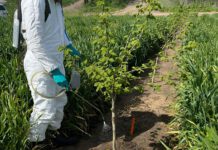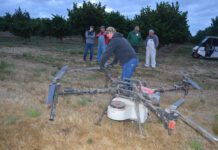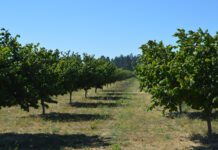
Listen to the audio version of this article. (Generated by A.I.)
Jess Paulson, Oregon’s agribusiness manager for Ferrero, looks nervous. He and Jovan Campbell, a company hazelnut buyer, had to abandon their popular booth to talk to the hundreds of hazelnut growers, processors and distributors attending the Nut Growers Society 2025 Summer Tour.
Paulson had good reason to worry. Less than a half-hour before, I had stuffed as many Ferrero samples as I could into my mouth and purse while talking to the pair. Ferrero, in case you’ve been living under a chocolate-free rock, is the producer of Ferrero Rocher, Kinder wafers, Nutella and other trademarked products, almost all of which are made with hazelnuts. Samples of all those hazelnut goodies were left unattended while the pair spoke to attendees.
“If there’s something left when we get back,” Paulson joked, “come visit our booth and take some samples.”
His introduction was lighthearted, but his mission is serious. Ferrero wants to see more hazelnuts coming from Oregon. Although Oregon’s hazelnuts are just a small percentage of the world’s production, Paulson applauded western trade organizations, including the Nut Growers Society and the Oregon Hazelnut Commission, which smooth the transition from the field to the consumer.
Ferrero, based in Luxembourg, has expanded in the United States with the purchase this year of the Kellogg Co., a $3.1 billion transition. Kellogg is not the only U.S. company Ferrero has recently acquired. Others include Butterfinger, Keebler, Jelly Belly, Nerds and frozen treat brands like Blue Bunny.
Oregon’s reliable production of hazelnuts is fueling growth in Ferrero’s nut merchandise, Paulson said. Weather, trade policies and delivery challenges in Turkey, Europe, South America and other nut-producing regions create opportunities for U.S. growers, where almost all the hazelnuts are grown in the West.
“Oregon is important to us. It’s our last frontier,” Paulson said.
Ferrero has been buying Oregon hazelnuts since the early 2000s, Campbell said. “I like to think that Ferrero played a small part in this group’s success.”
Ferrero now has an office in Tigard, although Paulson and Campbell are usually out in the field visiting growers and looking for ways to maintain a high-quality supply of hazelnuts.
“Mostly, we’re learning from you. You all continue to make my life easy,” Campbell said, adding that Oregon is known for its quality, its consistent crops and its professional growers. “You guys work so well. Let’s not mess with that.”
And what about the future, someone asked.
“Ferrero expects to need more hazelnuts in the future,” Paulson said. “We want more hazelnuts from Oregon.”
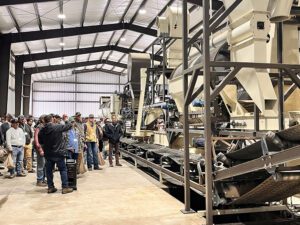
Blight Set Aflight
If Ferrero was the tastiest topic at the tour, the most welcome session at the gathering may have been the one that promised future relief from the threat posed by a new race of eastern filbert blight, or EFB. The new race of blight, discovered two years ago in the Willamette Valley, appears to be overwhelming some cultivars with the Gasaway gene that had been bred to be resistant to EFB. But as cankers again began to appear in some orchards, researchers have gathered their best and brightest to set about restoring health to U.S. hazelnut trees.
Gaurab Bhattarai and Jacob Snelling, both Oregon State University (OSU) researchers, described in detail the Hazelnut Breeding Program’s objectives aimed at filling a list of complements to improve hazelnuts’ marketability, in addition to creating a tree with resistance to the new blight.
Step one: identifying the culprit. Snelling described a new comparison process that accelerates the process to identify genetic material differences. The array SNP, short for Single Nucleotide Polymorphisms, eliminates a slower identification process, which takes a few months and involves removal SNP of catkins, bagging of female flower branches, pollen collection and lab work using a microscope. Acceleration helped researchers discover that the new blight was actually a mutation, or a new race related to the old one.
Using new techniques, researchers discovered that there are other types of resistance to the blight beyond the inherited Gasaway gene endemic to most of the current cultivars. The Italian Tonda di Giffoni cultivar, for example, is highly resistant due to several genes acting together.
Bhattarai said a new cultivar could be released this year, followed later by several other promising selections now in trial. This cultivar carries a non-Gasaway gene that seems resistant to EFB’s mutation. All current OSU-released EFB-resistant cultivars are protected by the Gasaway resistance gene, which the new race has overcome.
Although the new cultivar is promising, only longer-term tests will confirm its resistance to the new mutation.
“We have planted several trees of this cultivar along with many other resistance sources at Woodburn orchard, where the new EFB race is naturally present. In the near future, we will have a better understanding of its resistance,” Bhattarai said.
Moving forward, the SNP array will be an important resource in cultivar identification, parentage confirmation and identifying DNA markers for a new source of EFB resistance, as well as other important nut and kernel quality traits in hazelnuts. These SNP-based DNA markers can then be used in selecting hazelnut seedlings at an earlier stage without actually looking at the traits in a growing plant, according to Bhattarai.
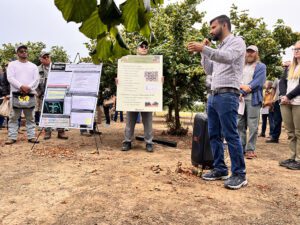
Dryer Daze
Winning the prize for the most ‘oohs’ and ‘ahhs’ from machinery-mad growers attending the tour was Kevin Coleman’s family KCK Farms Receiving Station, one of the newest hazelnut wash/dry facilities in the Northwest. The station is in the Willamette Valley near Dayton, central to Oregon’s hazelnut-growing region.
The technology for the station is not entirely new; there’s a high-capacity washer, de-husker, de-sticker, de-rocker, 15 stack dryers and a 70-foot truck scale. However, the custom design by Ed Charron of Willamette Ag Solutions is unique. The one-stop nut processor is in a single-line setup in a 10,000-square-foot building.
Growers weigh in on the scale at the front of the receiving station. From there, they dump their nuts into a specific bay, or, in some cases, directly into the pit that feeds into the wash line. After the weight is recorded into the system, the nuts enter the wash line, are washed, then conveyed into dryers. After the drying process, they are conveyed back into trucks and delivered to George Packing.
What’s the advantage of the in-line process?
“You can inspect any point of the line while being able to access either side for repairs,” Coleman said. “Nuts run on a linear pattern, so you’re not making any turns.”
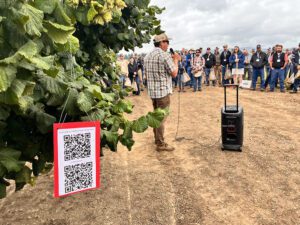
Food for Thought
Feeding hazelnuts what they need to thrive is made difficult by the fact that nuts can’t talk. However, a leaf tissue sample can speak volumes, literally. As in volumes of nitrogen, phosphorus, potassium, calcium, magnesium and sulfur, according to a quick overview by Nik Wiman, hazelnut researcher for OSU. While hazelnut leaves aren’t typically eaten (except, of course, by the notorious filbert aphid and other leaf-eating parasites), “…nut clusters pull certain nutrients from leaves,” Wiman wrote in his eight-page overview of nutrient research.
Traditionally, leaf-nutrient levels are tested in August, and findings inform growers about deficiencies.
But sap analysis may help growers gain other insights about orchard nutrition and more quickly identify deficiencies before they show up in leaves and nuts. Wiman also discussed research on nonstructural carbohydrate analysis, which can determine blooms and potential yields up to two years in advance.
Research continues on sap analyses and other methods that target timing of nutrient tests, and testing nutrients in bark, shoots, flowers, buds, the nut and the shell. Also investigated: What impact does removing the plant material, from the nut to the tree, have on the whole orchard’s health? And the most important question: Which tests best indicate productivity? The answer to that, Wiman suggested, depends on seasonal and orchard variations. Forewarned is forearmed though. Wiman’s hazelnut nutrient research paper is available by emailing him at nik.wiman@oregonstate.edu.
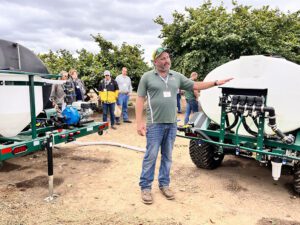
But Wait, There’s More
With the Ferrero chocolate high wearing off, I stopped by the hazelnut bakery showcase tent and loaded up on some carbohydrate-based nutrients, including nut cookies, toffee, granola, cakes and ganache, and my favorite from New Morning Bakery, Noel Bars. Conspicuously dusted with powdered sugar and now easily excitable, I made my way to the machinery demonstrations, including a sucker sprayer and two self-propelled sprayers. The HAV500, demonstrated by Matt Wood, reduces expenses by saving on fuel and time for refills. Marcel Moretti showed off the efficient new Exact sucker sprayer. These demos were among nearly three dozen vendors, including educational groups, who took part in the annual gathering.
At the main Nut Growers Society information tent, I watched some very creepy (and alive) long-horned beetles crawl around in a plastic box before I grabbed some information on the use of the Samurai wasp to control aphids, a paper on native plant groundcover and basalt dust soil amendments.
Save the date Jan. 8, 2026, for the annual Winter Meeting of the Nut Growers Society at the Linn County Expo Center in Albany, Ore. For information on the society’s events or to join the group, visit the website at members.oregonhazelnuts.org.







